STUTTHOF CONCENTRATION CAMP PART 9/10
Death on the gallows
The following gut-twisting images are among a number to be found here.
The following gut-twisting images are among a number to be found here.
 |
| 4th July1946 Biskupia Gorka ( Stolzenberg ) near Gdansk (Danzig) Poland Above: on one end of the gallows row, the truck has just pulled away from Jenny Wanda Barkmann — a modish Hamburg lass in her mid-20’s known to Stutthof prisoners as “the Beautiful Specter” for her cruelty. Down the row, one can see that some of the prisoners are already swinging, while others have not yet been dropped. |
Between 25th April and 31th May before the Special Law Court at Danzig a trial was held against guards of the Stutthof Concentration Camp The accused were :
1. Camp’s Commandant Johann Pauls – death by hanging
2. SS-Aufseherin Jenny Wanda Barkmann – death by hanging
3. SS-Aufseherin Elisabeth Becker – death by hanging
4. SS-Aufseherin Wanda Klaff – death by hanging
5. SS-Aufseherin Ewa Paradies – death by hanging
6. SS-Aufseherin Gerda Steinhoff – death by hanging
7. SS-Aufseherin a Beilhardt - 5 years in prison
8. Kapo Joseph Reiter – death by hanging
9. Kapo Waclaw Kozlowski – death by hanging
10. Kapo Franciszek Szopiñski – death by hanging
11. Kapo Jan Brajt – death by hanging
12. Sztubowy Tadeusz Kopczyñski – death by hanging
13. Kapo Kazimierz Kowalski – 3 years in prison
14. Kapo Aleksy Duzdal – not guilty
15. Kapo Jan Preiss – not guilty
16. Kapo Marian Zielkowski – died of a heart attack 25th August 1945 in prison
 |
The bench of the accused
First row from left to right : Elisabeth Becker, Gerda Steinhoff, Wanda Klaff
Second row : Erna Beilhardt , Jenny Wanda Barkmann
|
At the trial the SS-women behaved insolently. During the interruptions they giggled and joked. Jenny Barkmann changed her hair-do every day and flirted with the guards. When public prosecutor asked for capital punishment Klaff, Steinhoff, Becker and Paradies cried and pleaded for her life Only Jenny Barkmann remained calm .
 |
| The gallows are waiting for the 6 men and 5 women sentenced to hang |
 |
SS-Guard Jenny Barkmann and her executioner
( in striped KZ uniform)
|
 |
| From right to left : SS-Guard Elisabeth Becker (sitting) , then Wanda Klaff (standing ) , Gerda Steinhoff (not visible) and 6 men (Kommandant Johann Pauls and 5 Kapos) |
 |
The priest speaks to Ewa Paradies,
at the left (sitting) : Elisabeth Becker
|
The hands of the prisoners were tied behind their back and the feet were tied together. The SS-women sat on chairs and had their hands tied in the back . For the execution they were lifted up on the chairs , this was very difficult as they had their legs already tied at the ankles.
 |
A few moments before the execution :
from right to left : Ewa Paradies, Elisabeth Becker , Wanda Klaff, Gerda Steinhoff
Upon hearing her sentence, Jenny Barkmann retorted, “Life is indeed a pleasure, and pleasures are usually short.” (More about Barkmann, including trial photos, here.) In this closer view of her, just as in the first photo, she is still alive and struggling. Next to her, Ewa Paradies, another guard, is prepared for the same fate. |
 |
| Wanda Klaff |
 |
| Wanda Klaff |
 |
Gerda Steinhoff |
Image result for Jenny Wanda Barkmann Trial
The disposition of the gallows
The execution started at 5.00 pm
The prisoners were noosed and then pushed from the ramp of the trucks Jenny Barkmann has just been hanged and struggles at the end of the rope while Ewa Paradies is being noosed by her executioner. In the background (white dress): Wanda Klaff . Already hanging with the back to the camera ( dark blouse, white skirt) : Gerda Steinhoff
After the hanging of the Nazi war criminals
 |
| Gerda Steinhoff The central triple gallows. Commandant Johann Pauls hangs in the middle with Gerda Steinhoff — one of the senior female guards — in the foreground. The line of five male kapos recedes behind them into the enormous crowd of onlookers. |
 |
| Left : Jenny Barkmann, Ewa Paradies, Elisabeth Becker, Wanda Klaff and Gerda Steinhoff |
 |
From left to right : Jenny Barkmann , Ewa Paradies, Elisabeth Becker ,
Wanda Klaff ,

SS guard executed at Stutthof Concentration Camp http://www.HolocaustResearchProject.or
|
It seems that one picture of the execution appeared in an edition of TIME Magazine of July or August 1946 under the title :"Ladies first !"
https://www.youtube.com/feature=player_embedded

Stg44 Don saved to 1.Collaboration and Retribution

Mutilating a female corpse - Oriental style. (Location unknown, source - P interest)/ I do not think that the Poles ever sunk that low, yet the question of the disposal the dead is never answered
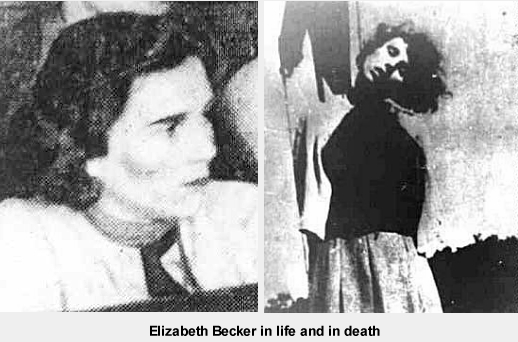

Stg44 Don saved to 1.Collaboration and Retribution

Mutilating a female corpse - Oriental style. (Location unknown, source - P interest)/ I do not think that the Poles ever sunk that low, yet the question of the disposal the dead is never answered

The Polish press informed :
- about 50 000 people (Dziennik Polski 5th July 1946) - this seems a little bit exaggerated
- several dozen thousands (Ilustrowany Kurier Polski no 186 12th July 1946)
- great crowd (another paper)
The information about the coming execution were given the day before, on 3th July 1946 (Wednesday), in the newspaper “Dziennik Baltycki”: “Stutthof’s war criminals will be publicly hanged in Gdañsk”.
It is believed that the execution was filmed. During the visit of Stutthof’s Museum a film “Stutthof’s gallows” is being shown. In this film (newsreel) there are scenes of the SS-women in the accused bench , for instance Jenny Barkmann, when she is standing up for the death verdict. Maybe the complete film showing the executions is in the Museum's archives or perhaps in a Russian archiv. The Polish Clergy strongly opposed the public hanging, including its method of strangulation, as the entire procedure had an atmosphere of a fun-fair. Food-stalls were opened and ice-cream was freely available for the consumption to the public. This type of hanging was never repeated. The public execution took place on 4 July 1946 along with ten other victims on the hill Biskupia Górka (German Stolzenberg) not far from Gdansk (Danzig). The condemned were meant to be executed by the so-called Slow Hanging, for the entertainment of the public in which the condemned were driven slowly off the tail gate of the back of trucks and thus due to the low hight, strangled slowly by hanging. This could last for a full 20-minute of agony and straggle of the hanged before death sat in. Since the condemned were hanged in succession with twelve minuets intervals they could see what was in store for them. Jenny Barkmann was the first of those convicted on whom this procedure was performed by her executioner , a former concentration camp inmate.
THE TRIAL THE ACCUSED THE EXECUTION
The camp was liberated by the Russians on May 10th, 1945 and the Commandant, Johann Pauls, and some of his staff were put on trial by the Polish Special Law Court at Danzig between April 25th and May 31st, 1946. All were represented by counsel. Eleven of the defendants, five women and six men, were found guilty of war crimes and sentenced to death. These were Johann Pauls, SS-Aufseherins Jenny Wanda Barkmann, Elisabeth Becker, Wanda Klaff, Ewa Paradies, Gerda Steinhoff and five other men who had been Kapo's in the camp.

View of Stutthof after Liberation

View of Stutthof after Liberation
They had all pleaded "not guilty" to the general charge of war crimes and the women did not seem to take the trial too seriously until the end. After the sentence, they appealed for clemency but these appeals were rejected by the Polish president. Thus all 11 were publicly hanged before a large crowd, estimated at several thousand, at 5.00 p.m. on July 4th, 1946 at Biskupia Gorka hill near Danzig. A row of simple gallows had been set up in a large open area, four double ones with a triple gallows in the middle. A fleet of open trucks brought the prisoners to the execution ground, their hands and legs tied with cords. The trucks were backed under the gallows and the condemned made to stand on the tailboards or on the chairs on which they had sat. A simple cord noose was put round their necks and when the preparations were complete, each truck was driven forward leaving them suspended. They were not hooded and given only a short drop, and as can be seen from the photos, some of them struggled for some time after suspension. It is alleged that one man and two women (un-named) struggled and fought with their guards prior to being hanged, although the others seemed to accept their fate calmly. The whole event was recorded by official press photographers, hence the clarity of the pictures.
Twenty four year old Jenny Wanda Barkmann was thought to be from Hamburg and was nicknamed "The Beautiful Spectre" by the camp inmates who considered her to be a ruthless killer. She was arrested in May 1945 at a railway station near Danzig trying to escape. At her trial she is reported to have flirted with her male guards and wore a different hairstyle each day. She is reported to have said after being condemned: "Life is a pleasure and pleasure as a rule is a short distance".
Elizabeth Becker was not quite 23 years old and had been born locally on the 20th of July 1923 at Nowy Staw near Danzig. She had married in 1936 and had been a member of the NSDAP and the BDM from 1938 to 1940. She worked in agriculture from 1941 to 1944 in Nowy Staw and joined the staff of Stutthof in September 1944 becoming an SS Aufseherin in SK-III Stutthof (the women’s camp) where she made selections for the gas chambers. After she was condemned, she submitted an appeal for commutation of her death sentence to the Polish president. The court recommended the commutation and substitution of a 15 year term of imprisonment because she had committed far fewer and less dreadful crimes than the others. The president, Boleslaw Bierut, however, rejected this request and she was executed with the rest of the women.
Wanda Klaff (nee Kalacinski) was of German origin but had been born in Danzig on the 6th of March 1922. When she left school in 1938 she initially worked in a jam factory, leaving in 1942 to get married to one Willy Gapes and becoming a housewife. In 1944 Wanda joined the staff at Stutthof satellite camp at Praust, moving later to Russoschin sub-camp. She contracted typhoid and was hospitalised in Danzig where she was arrested on the June the 11th, 1945. It would appear form the photos that Wanda, unlike the other four, was hanged by a woman, rather than a male former camp inmate.
Gerda Steinhoff was 24 and also from Danzig. She worked on a farm in Tygenhagen and later in a baker's shop in Danzig until 1944. She married in January 1944 and had one child. She went to work for the SS at Stutthof in October 1944 and was quickly promoted to Oberaufseherin at KZ Danzig (a satellite of Stutthof). In January 1945, she moved to KZ Bydgoszcz (another satellite camp) where she remained until it was liberated. She received the “Iron Cross” for her wartime efforts. She was arrested by Polish police on the 25th of May 1945.
Ewa Paradies was born at Lauenburg, (now Lebork) in Poland on the 17th of December 1920 and had various jobs after leaving school in 1935. She joined the staff of Stutthof SK-III in August 1944 and was trained as an Aufseherin, being transferred to the Bromberg-Ost subcamp of Stutthof in October 1944 and returning to Stutthof in January 1945. She was arrested in May 1945 at Lauenburg....
EPILOGUE
One can only wonder, looking back from 70 years later what turned these women into virtual monsters. Was it their total belief in the rightness of Hitler's policies or did they possess a latent sadism or perhaps a mixture of both? It is terrifying the acts that people can commit when they are out of control and have no fear of the consequences. I suspect that these women thought that Germany would win the war and that they would rise in the regime. Typically, they viewed their prisoners as "Dreck," the German for dirt and as sub-humans (Untermenschen). Therefore, the prisoners' lives and feelings were completely irrelevant, and it was just a simple matter of controlling them through fear and brutal repression. One wonders too whether they just became inured to the continuous acts of cruelty. Many of the people tried for war crimes insisted that they were just carrying out orders from above but this doesn't really ring true, either now or to the judges at their tribunals, when one looks at the acts of sadism that they dished out on their prisoners.
It is easy to have sympathy with the young women from Stutthof, whose unnecessarily cruel executions were so well documented, but one must remember what they did. As a young soldier said to Pierrepoint on the eve of the hangings of the Belsen women, "if you had been in Belsen under this lot, you wouldn't be able to feel sorry for them." (Pierrepoint had expressed some sympathy for the female prisoners. What is rarely mentioned that the original hangman, Ronald Cook, refused to hang Irma Grese, Or for that matter any female. (She would sing German folk ballads at night in her cell.'STIRB NICHT' 'Don't die'. She hummed this tune as she walked to the gallows) and Cook was replaced by Pierrepoint, who had to be flown in from Ireland or England, who was willing to perform the task. Major Jerome Burdik ordered him (Ronald Cook) to hang her, and that night he went home and shot himself. Albert Pierrepoint was on record as the hangman but in 1978 two of Irma's MPs revealed the truth. Sgt O'Hare and Cpl Rick Smith were court marshalled for refusing to walk her to the gallows. Pierrepoint, as an experienced hangman may have miscalculated her weight, which is doubtful, or the length of the drop, her neck did not break and she struggled for more than three minutes before she crossed the great divide.

Alleged photograph of the notoriousIrma Grese

Irma Grese

The gallows where Irma Grese was executed
There was apparently an altercation with Pierrepoint, when he tried to put the black hood over Grese's head, she refused the hood as the hangman tried to put the rope over her head she became violent, and fought to be touched. Pierrepoint then slapped her repeatedly and forced the rope over her neck, but not in the prescribed manner, probably resulting in strangulation. (Pierrepoint did this without conscience or human feeling, only motivated by greed, to ensure that he received a set fee for each hanging and this was the reason that he resigned in 1956 over a disagreement with the Home Office about his fees. In January 1956, he had gone to Strangeways Prison, Manchester, to officiate at the execution of Thomas Bancroft, who was reprieved less than 12 hours before his scheduled execution, when Pierrepoint was already present making his preparations – the first time in his career that this had happened in England. He claimed his full fee of £15 (£317 when adjusted for inflation) but the under-sheriff of Lancashire offered only £1. However in my opinion he was a killer rather than a symphonic executioner to ensure he received his compensation. By this time, aged 50, his eyesight was so bad hat he put the noose around the neck of his assistant, yet he took pride in his achievements, when one reads the sugar-sweet biography of his ghost-writer.A Had it not been for the war, one suspects that these women would most probably have lived normal lives with jobs, husbands and children.

Alleged photograph of the notoriousIrma Grese

Irma Grese

The gallows where Irma Grese was executed
There was apparently an altercation with Pierrepoint, when he tried to put the black hood over Grese's head, she refused the hood as the hangman tried to put the rope over her head she became violent, and fought to be touched. Pierrepoint then slapped her repeatedly and forced the rope over her neck, but not in the prescribed manner, probably resulting in strangulation. (Pierrepoint did this without conscience or human feeling, only motivated by greed, to ensure that he received a set fee for each hanging and this was the reason that he resigned in 1956 over a disagreement with the Home Office about his fees. In January 1956, he had gone to Strangeways Prison, Manchester, to officiate at the execution of Thomas Bancroft, who was reprieved less than 12 hours before his scheduled execution, when Pierrepoint was already present making his preparations – the first time in his career that this had happened in England. He claimed his full fee of £15 (£317 when adjusted for inflation) but the under-sheriff of Lancashire offered only £1. However in my opinion he was a killer rather than a symphonic executioner to ensure he received his compensation. By this time, aged 50, his eyesight was so bad hat he put the noose around the neck of his assistant, yet he took pride in his achievements, when one reads the sugar-sweet biography of his ghost-writer.A Had it not been for the war, one suspects that these women would most probably have lived normal lives with jobs, husbands and children.
It is notable that in many cases it was quite junior people who were caught, tried and in some cases executed. A lot of the more senior ones were able to escape justice. However, the Commandants of many of the concentration camps were caught and in most cases given the death penalty.
OTHER CAMPS
Belsen Concentration Camp staff
A total of 190 men and 10 women were hanged at Hameln Prison (near Hanover) in Germany under British jurisdiction. The executions were carried out by Albert Pierrepoint who was flown in specially on each occasion.[The stationed hangman at Hameln, Cook, refused to hang women, went home and shot himself. That was the only reason, Pierrepoint was specially flown in. [There were also two British Soldiers on court-martial that refused to take women onto the gallows. Although he, Pierrepoint, finished acrimoniously over an acrimonious dispute over payment.]
Generally he was assisted by Regimental Sergeant Major O'Neil who was a member of the Control Commission there. The hangings took place in a purpose built execution room at the end of one of the prison's wings. The gallows having been specially constructed by the Royal Engineers to allow the execution of prisoners in pairs.
It was decided that those sentenced to die should suffer death by hanging for both sexes, although no standard execution protocol was agreed. Each country carried out executions in accordance with its normal procedure. This led to the use of British style measured drop hanging in private, for those executed in the British sector, short drop hanging in public or private for those in the Polish and Russian sectors and standard drop hanging in semi-private for those executed by the Americans at Nuremberg, Dachau and Landsberg. Some of the American hangings were televised and shown on the news. No women were executed in the American Sector. The accused comprised of 16 men and 16 women, including Josef Kramer,Belsen 's commandant, plus 12 former prisoners (seven men and five women).
The Belsen Trial as it was known was conducted by the British Military Tribunal at No. 30 Lindentrasse, Lüneburg, in Germany from September 17th to November 17th, 1945 under court President Major-General H.M.P. Berney-Ficklin, sitting with five other officers. The prosecution was in the hands of a team of 4 military lawyers and each prisoner was represented by counsel. All the prisoners were tried together and sat in the large dock, each wearing a number on their chest.
On the afternoon of November 16th the verdicts were delivered. Thirty one prisoners were convicted on one or both counts and 14 acquitted of all charges. Irma Grese and Elisabeth Volkenrath were found guilty on both counts, Juana Bormann guilty only on the second charge. The following day the sentences were read out to the prisoners. Eleven of them were sentenced to death and 19 others to various terms of imprisonment.
The death sentences were pronounced as follows by Major-General Berney-Ficklin:
"No. 1) Kramer, 2) Klein, 3) Weingartner, 5) Hoessler, 16) Francioh, 22) Pichen, 25) Stofel, 27) Dorr. The sentence of this Court on each one of you whom I have just named is that you suffer death by being hanged".
He then passed sentence on the women as follows "No. 6) Borman, 7) Volkenrath, 9) Grese. The sentence of this court is that you suffer death by being hanged."
OTHER CAMPS
A total of 190 men and 10 women were hanged at Hameln Prison (near Hanover) in Germany under British jurisdiction. The executions were carried out by Albert Pierrepoint who was flown in specially on each occasion.[The stationed hangman at Hameln, Cook, refused to hang women, went home and shot himself. That was the only reason, Pierrepoint was specially flown in. [There were also two British Soldiers on court-martial that refused to take women onto the gallows. Although he, Pierrepoint, finished acrimoniously over an acrimonious dispute over payment.]
Generally he was assisted by Regimental Sergeant Major O'Neil who was a member of the Control Commission there. The hangings took place in a purpose built execution room at the end of one of the prison's wings. The gallows having been specially constructed by the Royal Engineers to allow the execution of prisoners in pairs.
It was decided that those sentenced to die should suffer death by hanging for both sexes, although no standard execution protocol was agreed. Each country carried out executions in accordance with its normal procedure. This led to the use of British style measured drop hanging in private, for those executed in the British sector, short drop hanging in public or private for those in the Polish and Russian sectors and standard drop hanging in semi-private for those executed by the Americans at Nuremberg, Dachau and Landsberg. Some of the American hangings were televised and shown on the news. No women were executed in the American Sector. The accused comprised of 16 men and 16 women, including Josef Kramer,
The Belsen Trial as it was known was conducted by the British Military Tribunal at No. 30 Lindentrasse, Lüneburg, in Germany from September 17th to November 17th, 1945 under court President Major-General H.M.P. Berney-Ficklin, sitting with five other officers. The prosecution was in the hands of a team of 4 military lawyers and each prisoner was represented by counsel. All the prisoners were tried together and sat in the large dock, each wearing a number on their chest.
On the afternoon of November 16th the verdicts were delivered. Thirty one prisoners were convicted on one or both counts and 14 acquitted of all charges. Irma Grese and Elisabeth Volkenrath were found guilty on both counts, Juana Bormann guilty only on the second charge. The following day the sentences were read out to the prisoners. Eleven of them were sentenced to death and 19 others to various terms of imprisonment.
The death sentences were pronounced as follows by Major-General Berney-Ficklin:
"No. 1) Kramer, 2) Klein, 3) Weingartner, 5) Hoessler, 16) Francioh, 22) Pichen, 25) Stofel, 27) Dorr. The sentence of this Court on each one of you whom I have just named is that you suffer death by being hanged".
He then passed sentence on the women as follows "No. 6) Borman, 7) Volkenrath, 9) Grese. The sentence of this court is that you suffer death by being hanged."
The sentence was translated for them into German as "Tod durch den Strang," literally death by the rope. All the prisoners were returned to Lüneburg prison. Nine of the eleven condemned appealed to the convening officer, Field-Marshal Montgomery, who rejected their appeals for clemency. Elizabeth Volkenrath and Juanna Borman decided not to appeal. On Saturday the 8th of December the appeals of the others were rejected and the condemned were transferred to Hameln Belsen had been joined by two other men, Georg Otto Sandrock and Ludwig Schweinberger, sentenced for the murder of Pilot Officer Gerald Hood, a British prisoner of war at Almelo Holland the 21st of March 1945 .
The executions were set for Friday, December the 13th, 1945 and were to be carried out at half hour intervals starting at 9.34 a.m. with Elisabeth Volkenrath, followed by Irma Grese at 10.03 a.m. and Juana Bormann at 10.38 a.m. The men, including Joseph Kramer, were hanged in pairs afterwards, all 13 executions being completed by 1.00 p.m. In view of the proximity of the condemned cells to the gallows, each one of them must have heard the preceding hangings. A contemporary newspaper reports stating that Elizabeth Volkenrath was executed first, with Irma Grese second but this does not accord with Albert Pierrepoint’s recollection of the events. Elisabeth Volkenrath was 26 years old. She was convicted of numerous murders and made selections for the gas chamber. She was described as the most hated woman in the camp. Juana Borman was known as “the woman with the dogs” and took sadistic pleasure in setting her wolfhounds on prisoners to tear them to pieces.
The afternoon before the execution each prisoner was weighed so the correct drop could be calculated for them. Irma Grese smiled at Pierrepoint when he asked her age. Elisabeth Volkenrath was steady but looked nervous and Juana Bormann limped down the corridor looking old and haggard.
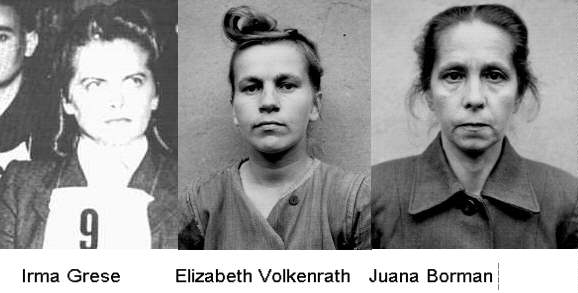 Ravensbrück concentration camp.
Ravensbrück concentration camp.
Ravensbrück concentration camp near Furstenberg in Germany April 30th, 1945 by the Russian Army. The estimated number of victims there were 92,000!
Sixteen members of the staff of were arrested and were tried betweenDecember 5th 1946 and February 3rd 1947 by a court in the British zone on charges of murder and brutality. All were found guilty on Monday, the 3rd of February 1947 , except one, who died during the trial. Eleven were sentenced to hang, including five women, head nurse Elisabeth Marschall, Aufseherin Greta Bösel, Oberaufseherin Dorothea Binz and Kapos Carmen Mory and Vera Salvequart.
41 year old Mory cut her wrists during the night of April 9th with a razor blade she had concealed in her shoe and thus escaped the noose. She was buried within the prison grounds. Swiss born Mory was unusual in that she had worked as a spy for the French, the Nazis and finally the British before and during the War and had been sentenced to death by each in turn but always managed to dodge her execution, by good fortune on the first two occasions. She was a prisoner in Ravensbrück, having been reprieved by the Nazis, and here she made the most of her situation by becoming a Kapo and spying on other prisoners and assisting the staff. Due to a shortage of personnel, the SS frequently used prisoners (Kapo’s) to supervise other non German inmates.
April 26th 1948 to hear the cases of five women officials from the Uckermark concentration camp and extermination complex. This was a satellite camp that housed girls aged 16 – 21. Two of the women were acquitted, two received prison terms but Ruth Closius was condemned to death. Ruth Closius, (married name Neudeck) was born in July 1920. She had belonged to the SS guard staff of Ravensbrück and had worked there in various capacities from the 3rd of July 1944 , including work in the punishment barracks in late 1944. She was promoted to Oberaufseherin (senior supervisor), at Uckermark in early 1945 and worked there until the camp was liberated. She was convicted of the torture and murder of men, women and children and of selecting prisoners for the gas chambers. She was hanged on the 29th of July 1948 .
The seventh series of Ravensbrück trials was held between July 2nd andJuly 21st, 1948 to hear the cases of Aufseherin accused of maltreatment of prisoners and making selections for the gas chambers. Two of the six were acquitted, two given prison terms and two sentenced to death. These were 60 year old Emma Zimmer, nee Menzel, and 36 year old Ida Bertha Schreiber (or Schreiter) who were hanged on the20th of September 1948. No other women were executed as result of the other Ravensbrück trials although others received death sentences which were later commuted to prison terms.
Auschwitz Concentration Camp.
Auschwitz was established in May 1940, on the orders of Heinrich Himmler, on the outskirts of the town of Oswiecim Poland Auschwitz and this became the name of the camp. It was expanded into three main camps, Auschwitz I, Birkenau, Auschwitz II - Monowitz and had some 40 satellite camps. Initially, Auschwitz was used to house Polish political prisoners, Soviet prisoners of war and gypsies. From June 1942, it was used as an extermination camp for European Jews who were killed in the gas chambers at - Birkenau. It is thought that around one million people died in this camp. It was liberated by the Red Army on January 27, 1945 .
The trial of the staff who had been captured took place atKrakow in Poland Krakow .
SS-Oberaufseherin Maria Mandel, a 36 year old blonde, was born at Munzkirchen inAustria the 30th of November 1944 . She was moved on to KZ Mühldorf where she continued until May 1945. Her arrest came on August 10th, 1945 . She was reported to be highly intelligent and dedicated to her work. The prisoners, however, referred to her as "the beast" as she was noted for her brutality and enjoyment in selecting women and children for the gas chambers. She also had a passion for classical music and encouraged the women's orchestra in Auschwitz . The orchestra were kept busy playing at roll calls, to accompany official speeches, to welcome transports and at hangings.
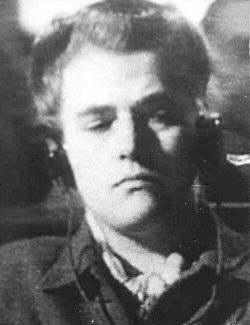
Therese Rosi Brandel been born inBavaria Auschwitz in 1942 and then to the KZ Muehldorf (a satellite camp of Dachau the 29th of August 1945 in the Bavarian mountains. This is a photo of her:
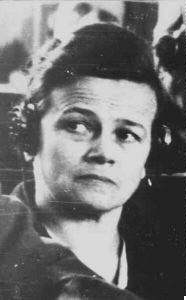
OnJanuary 24th, 1948 , all twenty one prisoners were executed in groups of five or six within the Montelupich prison in Krakow . The hangings commenced at 7:09 a.m. with Maria Mandel and four male prisoners, Artur Liebehenschel, Hans Aumeier, Maximilian Grabner and Carl Möckel. Each prisoner in turn was made to mount a simple step up. When they were noosed, this was removed leaving them suspended, slowly strangling to death. The four men were hanged one at a time, followed by Maria Mandel. It is reported that it was 15 minutes before they could be declared dead.
A second group of five prisoners, all men, were hanged at7.43 a.m. with a further five men following them at 8.16 a.m. The final group comprising of five men and the other condemned woman, Therese Brandl, went to the gallows at 8.48 a.m. Again, they were hanged one by one and were certified dead 15 minutes later.
After execution, the 21 bodies were all taken to theMedical School University of Krakow
A further woman to be hanged atKrakow was 46 year old Elizabeth Lupka.
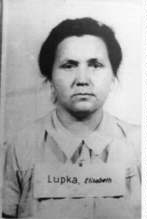
She was born onthe 27th of October 1902 in the town of Damner Berlin the 6th of June 1945 and brought to trial on the 6th of July 1948 at the district court in Krakow where she was convicted of war crimes and sentenced to death by hanging. She was executed on the 8th of January 1949 at 7.05 a.m. in the Montelupich prison in Krakow . Her body was also taken to the Medical School University of Krakow
Margot Drexler (also given as Dreschel) was another SS Aufseherin inAuschwitz who was particularly feared by the women inmates, whom she beat and starved to death. She had last worked at the Ravensbruck subcamp of Neustadt-Glewe. After the war, she tried to escape but was caught in Pirma-Bautzen in Czechoslovakia Bautzen
There are records of at least three other women who were executed.
Else Lieschen Frieda Ehrich Hildner, who had been the women's camp commandant at Majdanek concentration camp, was hanged on the 26th of October 1948 in the prison at Lubin in Poland. This is a photo of her:
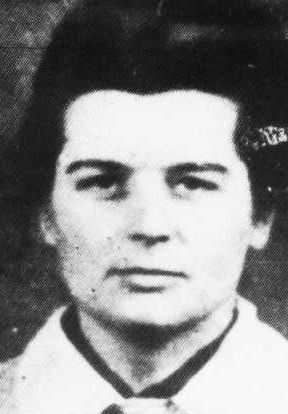
Ruth Elfriede Hildner was tried by the Extraordinary People's Court in Písek, Czechoslovakia on the 2nd of May 1947 and hanged six hours later, presumably using the pole hanging method. She had been a guard at Zwodau, a subcamp of Flossenburg, in Czechoslovakia.
Sydonia Bayer. Virtually nothing is known about this woman other that she trained at Ravensbrück and was tried and hanged in Poland.
It is terrifying the acts that people can commit when they are out of control and have no fear of the consequences. I suspect that these women thought that Germany would win the war and that they would rise in the regime. Typically, they viewed their prisoners as "Dreck," the German for rubbish and as sub-humans. Therefore, the prisoners' lives and feelings were completely irrelevant, and it was just a simple matter of controlling them through fear and brutal repression. One wonders too whether they just became inured to the continuous acts of cruelty. Many of the people tried for war crimes insisted that they were just carrying out orders from above but this doesn't really ring true, either now or to the judges at their tribunals, when one looks at the acts of sadism that they visited on their prisoners.
It is easy to have sympathy with the young women from Stutthof, whose unnecessarily cruel executions were so well documented, but one must remember what they did.
FEMALE GUARDS
Of the 55,000 guards who served in Nazi concentration camps, about 3,700 were women. In 1942, the first female guards arrived at Auschwitz and Majdanek from Ravensbrück. The year after, the Nazis began conscripting women because of a guard shortage.Female guards were generally low class to middle class and had no work experience; their professional background varied: one source mentions former matrons, hairdressers, street car ticket takers, opera singers, or retired teachers. Volunteers were recruited by ads in German newspapers asking for women to show their love for the Reich and join the SS-Gefolge ("SS- Retinue" an SS support and service organisation for women). Additionally, some were conscripted based on data in their SS files. The League of German Girls (BDM) acted as a vehicle of indoctrination for many of the women.

Bergen-Belsen female SS guards Magdalene Kessel, Anneliese Kohlmann, Hildegard Kambach/Kanbach, Charlotte Pliquet, Frieda Walter, Ilse Förster and Scharführer Friedrich Hertzog bury the dead in Mass Grave 2. With them are, as yet unidentified, male SS Administration Staff. Dated: 23 April 1945. British troops with fixed bayonets supervise the horror.There were many concentration camp guards in the Third Reich, and many of those were female. They were every bit as brutal as male guards. Not all have been brought to justice; in fact, one (unidentified so far) has just been charged on 260,000 counts in September 2015 for work she did at Auschwitz as a radio operator for the camp commandant from April to July 1944. The role of women in the Third Reich and World War II in general is greatly unexplored. If you believed the media and most textbooks, the only women alive in those times were working hard in American factories or in auxiliary Allied military units. That is manifestly false, women were a major factor on both sides during the war.
Heinrich Himmler's SS ran the camps, so the Germans who worked there technically were members of the SS. These guards formed the recruiting pool for the Death's Head Waffen SS Division, so many of the male guards eventually found their way to the front. The women, of course, did not fight. They remained as guards for the duration.
Prisoners were chosen to do much of the dirty work. The choice was to either work as a "kapo," a prisoner serving as a guard who worked under the supervision of the real guards, or to go to the gas chamber. It obviously was an impossible choice. The kapos became notorious for their own brutality, as they were anxious to please their masters and, perhaps regarding some of them, had some issues of their own.
Elisabeth Volkenrath (born 5 September 1919, Schönau an der Katzbach, Silesia – died 13 December 1945, Hamelin) was German supervisor at several Nazi concentration camps during World War II. Volkenrath trained under Johanna Langefeld at Ravensbrück concentration camp during 1941, and in 1942 went to Auschwitz Birkenau as an Aufseherin. In April 1945, she was arrested by the British Army and stood trial with Irma Grese. She was executed at Hamelin Prison later that year.
It is easy to bring preconceptions about females into your mental image of female camp guards. Don't. These ladies were as bad as the men: they were brutal, and expressed no remorse whatsoever. Many went to their hangings without renouncing a thing that they had done, and only wishing that they could have continued longer.
There could have been mitigating factors. For instance, some of the women may have been mentally infantile, or abused themselves, or simply unaware of concepts of right and wrong. Many peasant girls of the day were incredibly unsophisticated, and may not have been aware of the heinous nature of their activities.
All of that was taken into account during their trials, sentencing and execution (if found guilty of the most heinous offenses). Some were acquitted, many were hung.
Hildegard Lächert was nicknamed "Bloody Brigitte" (Krwawa Brygida in Polish). Many other witnesses characterized her as the "worst" or "the most cruel" Aufseherin, as "Beast", and as "Fright of the Prisoners." For her part in selections to the gas chamber, releasing her dog onto inmates and her overall abuse, the court sentenced her to 12 years imprisonment. Hildegard Lächert died in 1995 in Berlin, aged 75.
Dorothea Binz was an SS supervisor at Ravensbruck concentration camp. Her dedication to her work was described by fellow Nazis as unyielding. Patrolling camp with a whip in one hand and a German Shepherd at her side, Binze made inmates fall silent upon her approach. Whipping, beating and shooting female inmates earned her the job of supervising torture bunkers and training guards. Convicted of perpetrating war crimes, she was sentenced to death and hanged on May 2, 1947. The middle picture shows what many inmates probably saw right before they died.

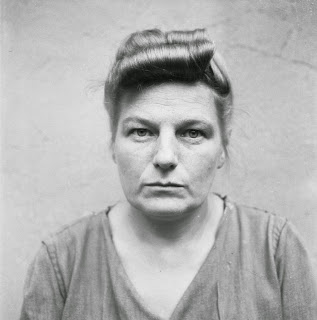
Bergen-Belsen camp guard Herta Ehlert: sentenced to 15 years imprisonment. Portrait taken August 1945 in Celle.February 3, 1947: After a trial lasting two months, all fifteen former members of the staff at Ravensbruck concentration camp, where 100,000 women were said to have died during WWII, were found guilty by the Hamburg war crimes court. 12 were sentenced to death. Pictured below is Carmen Mory, a “kapo” - a prisoner at the camp who was assigned by the SS to supervise forced labor. The kapos, desperate to please their evil bosses in order to avoid the gas chambers themselves, were often the most brutal of all. She was sentenced to death but committed suicide on April 9, 1947.
Johanner Altvater (above) and Lisolotte Meirer (below) killed Jews for sport during the Third Reich
Sixteen members of the staff of were arrested and were tried between
41 year old Mory cut her wrists during the night of April 9th with a razor blade she had concealed in her shoe and thus escaped the noose. She was buried within the prison grounds. Swiss born Mory was unusual in that she had worked as a spy for the French, the Nazis and finally the British before and during the War and had been sentenced to death by each in turn but always managed to dodge her execution, by good fortune on the first two occasions. She was a prisoner in Ravensbrück, having been reprieved by the Nazis, and here she made the most of her situation by becoming a Kapo and spying on other prisoners and assisting the staff. Due to a shortage of personnel, the SS frequently used prisoners (Kapo’s) to supervise other non German inmates.
On the 2nd of May 1947, Albert Pierrepoint hanged the remaining three women, one at a time starting with Elisabeth Marschall who was nearly 61 years old, followed by 39 year old Greta Bösel at 9.55 a.m. and then by 27 year old Dorothea Binz.
Elisabeth Marschall had been born on the 24th of May 1886 and became a nurse in 1909. She rose to the rank of Oberschwester (Head Nurse) in the Revier (hospital) barracks at Ravensbrück. Here she maltreated sick prisoners and also took part in horrific experiments. She also made selections for the gas chambers.
Greta Bösel was born on May 9th, 1908 in Elberfeld , Germany
Dorothea Binz had been born on the 16th of March 1920 in the town of Dulstarlake Hamburg
The third woman, 28 year old Czechoslovakian born Vera Salvequart had not been an SS guard, but rather a prisoner herself in Ravensbrück. She was born on the 26th of November 1919 in Wonotsch and had trained as a nurse. She had also served several periods in prison. She claimed to have stolen plans for the V2 rocket and passed these to Britain
Vera Salvequart petitioned the King for a reprieve in view of her passing secrets to the British. She was granted a stay while this was considered but the Royal prerogative of mercy was withheld and onthe 26th of June 1947 she followed the other three to the gallows, her body being buried with the rest in the grounds of Hameln
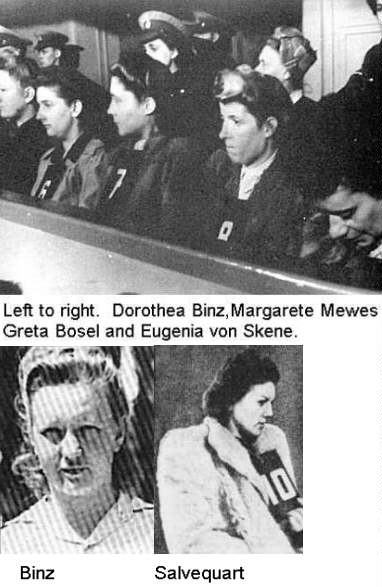
The third Ravensbrück trial, the so called "Uckermark trial", was held between April 14th and Vera Salvequart petitioned the King for a reprieve in view of her passing secrets to the British. She was granted a stay while this was considered but the Royal prerogative of mercy was withheld and on

The seventh series of Ravensbrück trials was held between July 2nd and
The trial of the staff who had been captured took place at
SS-Oberaufseherin Maria Mandel, a 36 year old blonde, was born at Munzkirchen in

Therese Rosi Brandel been born in

On
A second group of five prisoners, all men, were hanged at
After execution, the 21 bodies were all taken to the
A further woman to be hanged at

She was born on
Margot Drexler (also given as Dreschel) was another SS Aufseherin in
There are records of at least three other women who were executed.
Else Lieschen Frieda Ehrich Hildner, who had been the women's camp commandant at Majdanek concentration camp, was hanged on the 26th of October 1948 in the prison at Lubin in Poland. This is a photo of her:

Ruth Elfriede Hildner was tried by the Extraordinary People's Court in Písek, Czechoslovakia on the 2nd of May 1947 and hanged six hours later, presumably using the pole hanging method. She had been a guard at Zwodau, a subcamp of Flossenburg, in Czechoslovakia.
Sydonia Bayer. Virtually nothing is known about this woman other that she trained at Ravensbrück and was tried and hanged in Poland.
It is terrifying the acts that people can commit when they are out of control and have no fear of the consequences. I suspect that these women thought that Germany would win the war and that they would rise in the regime. Typically, they viewed their prisoners as "Dreck," the German for rubbish and as sub-humans. Therefore, the prisoners' lives and feelings were completely irrelevant, and it was just a simple matter of controlling them through fear and brutal repression. One wonders too whether they just became inured to the continuous acts of cruelty. Many of the people tried for war crimes insisted that they were just carrying out orders from above but this doesn't really ring true, either now or to the judges at their tribunals, when one looks at the acts of sadism that they visited on their prisoners.
It is easy to have sympathy with the young women from Stutthof, whose unnecessarily cruel executions were so well documented, but one must remember what they did.
FEMALE GUARDS
Of the 55,000 guards who served in Nazi concentration camps, about 3,700 were women. In 1942, the first female guards arrived at Auschwitz and Majdanek from Ravensbrück. The year after, the Nazis began conscripting women because of a guard shortage.Female guards were generally low class to middle class and had no work experience; their professional background varied: one source mentions former matrons, hairdressers, street car ticket takers, opera singers, or retired teachers. Volunteers were recruited by ads in German newspapers asking for women to show their love for the Reich and join the SS-Gefolge ("SS- Retinue" an SS support and service organisation for women). Additionally, some were conscripted based on data in their SS files. The League of German Girls (BDM) acted as a vehicle of indoctrination for many of the women.

Bergen-Belsen female SS guards Magdalene Kessel, Anneliese Kohlmann, Hildegard Kambach/Kanbach, Charlotte Pliquet, Frieda Walter, Ilse Förster and Scharführer Friedrich Hertzog bury the dead in Mass Grave 2. With them are, as yet unidentified, male SS Administration Staff. Dated: 23 April 1945. British troops with fixed bayonets supervise the horror.There were many concentration camp guards in the Third Reich, and many of those were female. They were every bit as brutal as male guards. Not all have been brought to justice; in fact, one (unidentified so far) has just been charged on 260,000 counts in September 2015 for work she did at Auschwitz as a radio operator for the camp commandant from April to July 1944. The role of women in the Third Reich and World War II in general is greatly unexplored. If you believed the media and most textbooks, the only women alive in those times were working hard in American factories or in auxiliary Allied military units. That is manifestly false, women were a major factor on both sides during the war.
Heinrich Himmler's SS ran the camps, so the Germans who worked there technically were members of the SS. These guards formed the recruiting pool for the Death's Head Waffen SS Division, so many of the male guards eventually found their way to the front. The women, of course, did not fight. They remained as guards for the duration.
Prisoners were chosen to do much of the dirty work. The choice was to either work as a "kapo," a prisoner serving as a guard who worked under the supervision of the real guards, or to go to the gas chamber. It obviously was an impossible choice. The kapos became notorious for their own brutality, as they were anxious to please their masters and, perhaps regarding some of them, had some issues of their own.
Elisabeth Volkenrath (born 5 September 1919, Schönau an der Katzbach, Silesia – died 13 December 1945, Hamelin) was German supervisor at several Nazi concentration camps during World War II. Volkenrath trained under Johanna Langefeld at Ravensbrück concentration camp during 1941, and in 1942 went to Auschwitz Birkenau as an Aufseherin. In April 1945, she was arrested by the British Army and stood trial with Irma Grese. She was executed at Hamelin Prison later that year.
It is easy to bring preconceptions about females into your mental image of female camp guards. Don't. These ladies were as bad as the men: they were brutal, and expressed no remorse whatsoever. Many went to their hangings without renouncing a thing that they had done, and only wishing that they could have continued longer.
There could have been mitigating factors. For instance, some of the women may have been mentally infantile, or abused themselves, or simply unaware of concepts of right and wrong. Many peasant girls of the day were incredibly unsophisticated, and may not have been aware of the heinous nature of their activities.
All of that was taken into account during their trials, sentencing and execution (if found guilty of the most heinous offenses). Some were acquitted, many were hung.
Hildegard Lächert was nicknamed "Bloody Brigitte" (Krwawa Brygida in Polish). Many other witnesses characterized her as the "worst" or "the most cruel" Aufseherin, as "Beast", and as "Fright of the Prisoners." For her part in selections to the gas chamber, releasing her dog onto inmates and her overall abuse, the court sentenced her to 12 years imprisonment. Hildegard Lächert died in 1995 in Berlin, aged 75.
Dorothea Binz was an SS supervisor at Ravensbruck concentration camp. Her dedication to her work was described by fellow Nazis as unyielding. Patrolling camp with a whip in one hand and a German Shepherd at her side, Binze made inmates fall silent upon her approach. Whipping, beating and shooting female inmates earned her the job of supervising torture bunkers and training guards. Convicted of perpetrating war crimes, she was sentenced to death and hanged on May 2, 1947. The middle picture shows what many inmates probably saw right before they died.


Bergen-Belsen camp guard Herta Ehlert: sentenced to 15 years imprisonment. Portrait taken August 1945 in Celle.February 3, 1947: After a trial lasting two months, all fifteen former members of the staff at Ravensbruck concentration camp, where 100,000 women were said to have died during WWII, were found guilty by the Hamburg war crimes court. 12 were sentenced to death. Pictured below is Carmen Mory, a “kapo” - a prisoner at the camp who was assigned by the SS to supervise forced labor. The kapos, desperate to please their evil bosses in order to avoid the gas chambers themselves, were often the most brutal of all. She was sentenced to death but committed suicide on April 9, 1947.
Carmen Maria Mory was a Swiss Gestapo double agent, who was convicted of heinous crimes, including 60 murders, in the Hamburg Trials. She was also part-Filipina. Carmen was born to an English doctor Ernest Emil Mory and his Pinay patient, Leona Bischoff. Carmen earned the unflattering nickname of “The Black Angel of Ravensbrück”. Books and movies have been created about her — such as “Carmen Mory: Hände weg von diesem Weib” which loosely translates to “Carmen Mory: Stay away from this woman”.She was sentenced to death by hanging at the first Hamburg trials but she committed suicide in her cell by slashing her wrists before justice can be carried out.
Irma Grese. Defendant number 9, Irma Grese, dubbed the Beast of Belsen was convicted for crimes against humanity at the Belsen Trial and sentenced to death. She had been employed at various Nazi concentration camps including Auschwitz and Belsen. At her trial survivors provided detailed testimony of murders, tortures, and other brutal behaviour towards prisoners, especially women. She was 22 years old when she was executed. |
Johanner Altvater (above) and Lisolotte Meirer (below) killed Jews for sport during the Third Reich

Lisolotte Meirer

| This is the reverse view of the picture at the top of this page, showing the enormous pit into which the dead bodies were being placed by the female guards at Bergen-Belsen. German SS women remove bodies of their victims from trucks in the concentration camp at Belsen, Germany, on April 28, 1945. Starvation and disease killed hundreds of the many thousands imprisoned at the camp. British soldiers holding rifles in the background stand on the dirt which will fill the communal grave. There appears to be a silent crowd in the distance, watching. |









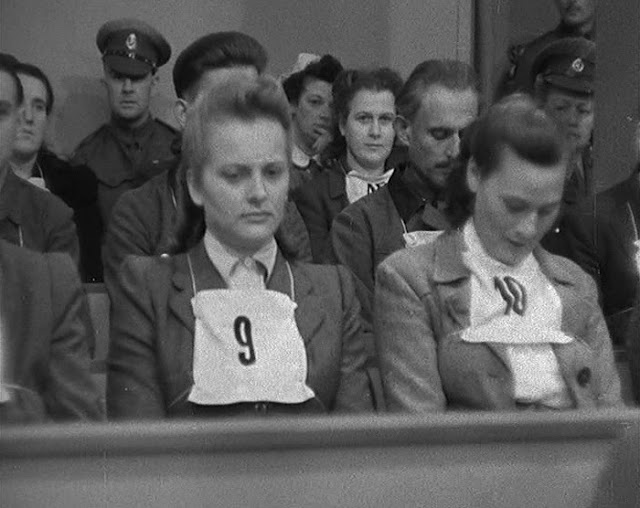
I'd like to know why pierrepoint slapped Irma It's a human reaction to survive!! guilty or not!!
ReplyDeleteIt is clear that she accepted her fate with great courage - perhaps she felt she was dying for her country - almost a form of martyrdom - perhaps she felt that it was the best way out for her as Germany had lost the war. With the training she had received it was a matter of honour to face death freely without the black hood, although she kissed the cross the priest held out to her, but was determined to face death with open eyes, that when an altercation occured, as she resisted the hood Pierrepoint tried to put over her head. I have now included a picture of her just prior to the drop.
DeleteThe execution pictured is not a Pierrepoint execution but an American one. Albert Peirrepoint did not use a knotted rope as shown in this picture too the arme were pinioned in a different position
ReplyDeleteThank you for pointing this out to me.
DeleteIrma Grese was second to be hanged but this does not accord with Albert Pierrepoint's recollection of the events. I was aware that typically he used a thin rope, fashioned into a simple slip knot.
I will recheck my source again and remove the picture, however, it is thus described in a picture gallery on the Internet.
Some sub-titles have been deleted by the censor.
ReplyDeleteH.K.Stolpmann